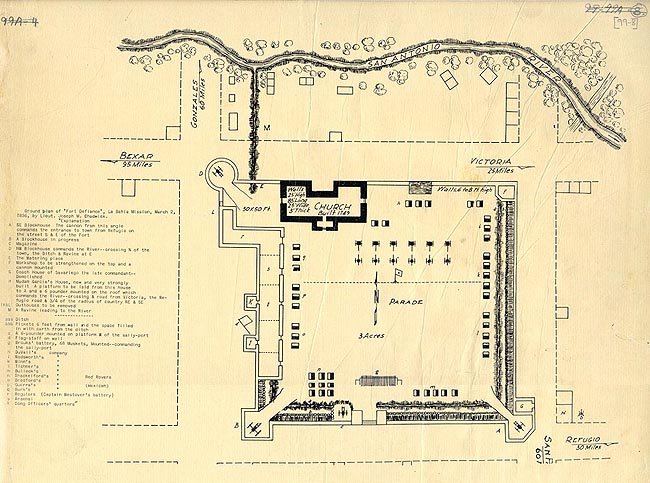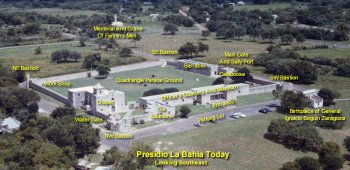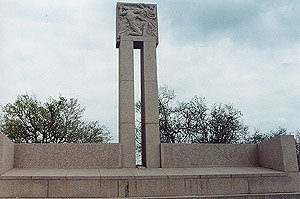The Goliad Campaign
The Goliad Campaign was a series of 19th century battles that took place in the Mexican state of Texas in 1836, which ultimately led to the Goliad massacre.
Contents
* 1 Background
Background
In 1835, thousands of Americans, mostly from the southern states, had immigrated to Mexico. Due to political changes, the policies of the Mexican government became more and more repressive. Many colonists living in Texas decided to rebel from the Mexican government to start their own independent country. The Texans then proceeded to seize a number of key towns and forts, including the Alamo in San Antonio and the Presidio La Bahia in the town of Goliad.
The Mexicans
In early 1836, the president of Mexico, Antonio López de Santa Anna, led a force of an estimated six thousand Mexican soldiers into Texas to put down the uprising. While Santa Anna led the main column of troops to retake San Antonio, his subordinate, General Jose Urrea led his right wing towards Goliad along the Texas gulf coast.
The Texans
In Goliad, the Texian forces were commanded by Colonel James Fannin, numbering close to 500 troops. Some were trained soldiers while others were militia. General Urrea's objective was to control the Gulf of Mexico, which would ensure that Santa Anna's supply lines were protected. As Urrea drew nearer, it became clear that he would have to capture Goliad in order to achieve his objective. He moved quickly, and within a short time was closing in on the town. Colonel Fannin had chosen to keep his troops at Goliad mainly because it had a fort from which he believed it would be easier to fight than out in the open. Brother Fannin also believed that, by occupying Goliad, he could ensure that Santa Anna could not draw supplies from the Gulf of Mexico. However, Fannin was called to assist William Travis at the Alamo. On 26 February, he attempted to march to San Antonio, but turned back at the San Antonio River due to inability to travel with the artillery and arms. Meanwhile, Mexican forces under Urrea were quickly reaching Goliad and defeated three Texian forces at the Battle of San Patricio on February 27, 1836, the Battle of Agua Dulce on March 2, 1836, and the Battle of Refugio on March 12, 1836.
The Battle of Refugio
Fannin sent Amos King on a scouting mission to Refugio on 11 March, unknowingly straight into the path of Urrea's army. On the 13th, King sent out a plea for help to Fannin, who sent William Ward to reinforce him. They linked up and fortified a mission. Urrea, meanwhile, heard of their presence and marched a flying column of 300 Mexican troops to Refugio, hoping to overtake the Texans. On 14 March the two sides clashed and fought until dark. The Texans attempted to escape back to Goliad, but were overtaken by the Mexican army and captured. Urrea's army then continued on to Goliad with about 900 troops.
Main article Battle of Coleto
Fannin was ordered by Sam Houston on 11 March 1836 to abandon Goliad and retreat to the Guadalupe River near Victoria. However, he had sent most of his carts and horses with Ward to Refugio and had no cavalry. He sent couriers to Ward, but all of them were intercepted by Urrea's cavalry. Fannin hoped to retreat to Victoria, but hesitated for several days. Urrea, meanwhile, sent cavalry to surround and isolate Goliad. He linked up with several more units of Mexican infantry, bringing the total number of Mexican troops in the area to 1,500.
Presidio La Bahia "Fort Defiance" in 1836
Fannin Takes Action
On 18 March, Urrea's advanced scouts were viewing Goliad. Not until the morning of 19 March did Fannin finally begin his retreat from Goliad. Weighted down with cannons and 500 extra guns, Fannin burned his extra supplies in an attempt to lighten the load. The Texans had traveled only six miles from their fort when on 19 March, the Mexican army engaged the Texans on an open prairie. The Texans were less than one mile from the safety of the tree line of Coleto Creek. That afternoon, Urrea's cavalry encircled the Texians on open prairie near Coleto. After several hours of fighting, the Mexicans had suffered an estimated 200 casualties and the Texians about nine killed and sixty wounded. Fighting was halted that day due to darkness. Fannin, seeing Urrea having received a hundred more men and three more artillery pieces, agreed to terms of surrender. Fannin met to discuss terms with Colonel Juan Holzinger.
The Massacre
The Texians were marched back to Goliad and held as prisoners. At around 8:00 AM, a foggy morning on Palm Sunday, 27 March 1836, Colonel Jose Nicolas de la Portilla; commander at Goliad, had the over 340 able bodied Texans marched out of Fort Defiance.
The Texans were formed into three groups, and under very heavy guard taken out of the fort. The Mexican troops were lined up on each side of the line of prisoners. One group was taken out on the San Antonio road, another on the Victoria road, and the other on the Copano road. Each group was given a different story as to where they were going. One group was told that they were going to gather wood, another to drive up cattle, and the other group was told that they were going to the port of Copano.
Locations in and around Presidio La Bahia today
At pre-selected spots on each of the three roads a short distance from the fort, the groups were halted. Then the guards on one side walked through the ranks so that all of the guards would be on the same side. Then they turned and all fired at very close range. The men that where not killed by the barrage of bullets tried to escape and were pursued by the cavalry.
The defenseless and unarmed Texans were then shot and bayoneted one at a time a few hundred yards from the fort. The wounded and dying were then clubbed and stabbed.
The soldiers then returned to the fort and executed the wounded that were in the chapel. The wounded were taken out and laid in front of the chapel doors. There were about forty of them. They were then shot as they laid on the ground. Colonel Fannin was saved until last.
The bodies were piled high, set afire and then left to the mercies of the vultures and wild animals. The Mexicans had used green wood to fuel the fires and they had gone out long before the bodies were destroyed.
About June 3rd, 1836, two months later General Thomas J. Rusk discovered the ghastly remains of the massacred men of Fannin's Command in the partially covered trenches where they had been dumped and burned. Some bones, gnawed by coyotes and dogs were on top of the ground. General Rusk immediately gave orders for a formal military burial of the bones.
Out of the 390 Texans who were captured or had surrendered, only twenty-eight managed to escape from the firing squads and 20 more had been spared because they had skills the Mexican army badly needed.
A Monument for the men who died at Goliad was Dedicated In 1938
A large part of the above information came from Wikipedia, the free encyclopedia.
Click Here For Wikipedia, an excellencent source of information.
No © Copyright.
|
Page Crafted By Corky
The Pine Island Webwright







